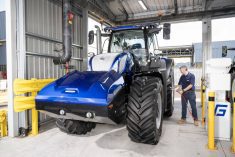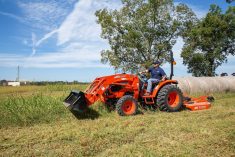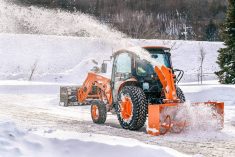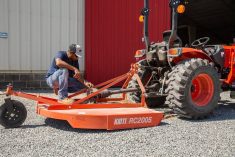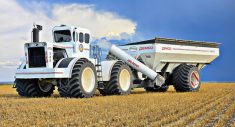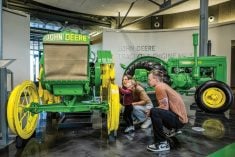As manufacturers have once again begun to amp up the muscle in their flagship tractor models, we continue to hit new highs in size and horsepower. But is that trend likely to continue?
Advancing technology might actually reverse it, and see farms return to smaller machines — at least, that’s the opinion of some of those involved in developing and offering full autonomy aftermarket systems.
Going smaller has a lot of advantages, including making financial sense, says Mike Burdick, sales director at Sabanto, a California-based firm offering bolt-on autonomy systems for regular production tractors.
Read Also

Claas brings 1000 Series SP forage harvesters to Canada
In mid-August, Claas unveiled its new line of Jaguar forage harvesters at an event in Visalia, California, deep in the heart of that state’s dairy region.
“We realized if we remove butts from seats, unit economics change,” he said. “The only reason (any brand) sells (high-horsepower) tractors is so you can pull wide implements and do X amount of work in a 12-, 18-, 20-hour day. But if you remove butts from seats, the real need for massive horsepower, we think, is going to go the way of the dinosaur.
“A 100-horsepower tractor can do the same work as a 500. It might take a little longer. It can do the same work with smaller implements. With no one in the seat, there’s no reason it can’t run 24 hours a day as long as you have fuel in it. Our in-house tractors do.”
READ MORE: The horsepower race in back on again
On the tractors Sabanto operates in its own work projects, it has installed larger fuel tanks to allow them to get that full 24 hours of uninterrupted work done. And with the automated control, the tractors function very precisely without any operator error.

“You really need to wrap your mind around what autonomy can do beyond the labour savings,” he added. “How can I truly optimize my operation? Frankly, we’re still learning (that) alongside our customers. The true benefit of autonomy, I think, is yet to be realized.”
“Part of the success is making sure guys are utilizing it correctly and exploiting as much value as possible,” Alon Ascher, chief business officer at Bluewhite, another autonomous aftermarket systems company, says.
“We’ve already shown reducing dramatically the operational costs. Reducing the amount of labour, machinery costs and inputs due to precision application, even reducing maintenance by driving the machinery in a much more precise and gentle way.”
For its part, Sabanto has designed add-on autonomous operation systems for three different models of tractors: the M5 Kubota, the 700 Series Fendt and, most recently, the 5100E John Deere.
The company is already working on automating other John Deere models. It is currently in the process of fitting a 5100M. The 5075E is next; the 6 Series will follow that.
“Our decisions on what tractors and what brands we apply our kits to are market driven,” Burdick explained.
And the initial focus on Deere tractors is the result of customer feedback the company garnered when displaying its system at agricultural trade shows, where many potential customers stated a preference for sticking with the green brand.
But overall, the company intends to remain independent of any particular brand.
“We really think we hit the nail on the head with regard to how we’re automating things,” Burdick added. “Not being beholden to any specific OEM. The true bolt-on philosophy is really a game changer.”
Ascher would agree with that assessment. His firm, which also has a strong presence in California, has also adopted the concept of taking regular utility-class production tractors and making them fully autonomous.
So far, Bluewhite has been working primarily with permanent-crop growers in California, such as orchards and vineyards.
Unlike Sabanto, though, Bluewhite’s systems are designed to be more generic in their application and can work with a wide variety of tractors. The key to that is applying them to those production models that are designed with the most basic control systems — what sales staff would call “low-spec’d” tractors.
Avoiding having to deal with more sophisticated computer-controlled systems allows the Bluewhite system to have a broader application across more models.
“Those tractors are very basic, very mechanical,” Ascher said. “They’re $50-, $60-, $70,000 tractors. We have low-level control, actually moving levers, rather than connect to a very sophisticated tractor computer. It gave us flexibility. We can install it on Kubota, Massey Ferguson, Fendt or whatever tractor. The models we chose are the models the customers have.”
Bluewhite has also paid attention to tractors its potential customers prefer. Sticking with the most common ones in use also helps ease the transition to robotic operation for farmers.
“It’s already a big shift moving from regular operation to autonomous operation,” Ascher says. “If we can keep the grower’s equipment, it really assists with adoption. A lot of companies are introducing a completely new robot that might have nice capabilities or better integration, but it’s not necessarily a good fit. So we’re using an aftermarket approach, installing (our technology) on top of existing equipment.”
Both companies provide similar digital management and control systems to allow a grower to operate the tractors efficiently.
The first step in getting a tractor fitted with the Sabanto technology to work autonomously is to create a detailed field map with boundaries.

“(It’s) what we call striking a boundary,” Burdick says. “You’ll tell the tractor where it can and can’t go. It cannot ever go outside of that boundary. If it does, it will shut itself off and send a signal to the user that ‘I’m in trouble; I need help.’
“Then you tell the software, ‘Mission Control,’ what you’d like done. Mowing, for instance. How fast you’d like to go. How fast you’d like to turn. What field work characteristics. Hit the go button, then the tractor is off and running.”
The system uses infrared- and normal-image cameras, as well as a geolocating system, to monitor the tractor and its surroundings as it works.
Owners can check on the tractor through the Mission Control portal, which displays the tractor’s surroundings and monitors its functions, such as fuel level and engine temperature.
If the tractor encounters something unexpected, it stops and notifies the operator.
“Stereoscopic cameras, front, back and side, allow growers to see what’s going on,” Burdick says. “So when they (operators) do get an alert (it) says ‘I’m stopped in the field for whatever reason, have a look at my cameras. Can I continue?’
“If, for example, a deer ran in front of the tractor, a grower can then look at the pictures that come to him or her at the time of the stop and determine whether or not that obstruction is still there or needs further attention. If the problem’s been alleviated, they can simply hit the play button again and the tractor will move.”
The “Compass” cloud-based system at Bluewhite allows growers the ability to control and direct the tractor to different jobs as well as track progress and accumulate field data.
“If in the past you needed to buy a rate controller, a screen in the cab and an additional connectivity package for telematics, GPS or things like that, now basically we can extract that data straight to our platform,” Ascher says. “So we have that extra control, extra information in the same app.
“Also ,there is a manager view to get reports on what actually happened. There is an end-of-day, end-of-week report, this is what happened, how many acres covered, the quality of the job. We’re moving to what we call Gen 3 this season. It will have more information and user interface. So you can control, monitor and see the data on everything that’s going on.”
The system allows for controlling an implement and changing its operating parameters as well.
“If it’s a sprayer, for example, you can set the rate; on a mower you can adjust the height needed, set different r.p.m.,” he said. “All the functions a typical operator would do, we can control. We also have what we call ‘Bluewhite ready,’ where we collaborate with an implement manufacturer to add extra sensors or controllers, things like that, to get the information to the platform.”

Both firms say they now have thousands of hours of operation with their customers’ lower-horsepower machines, which have covered tens of thousands of acres, so both companies are well beyond the prototype stage and into full commercial operation.
At Bluewhite, Ascher says, when it comes to cost there is a US$35,000 to $50,000 one-time setup fee and a $20,000-$30,000 annual subscription per tractor, depending on the operation’s requirements.
Sabanto is currently selling its system through about a dozen dealers across North America, including one in Ontario. Bluewhite is in the process of expanding its sales and distribution along the west coast of the U.S., but Ascher says it has plans for eventual expansion across all of North American and into Europe and Australia too.
“Generally speaking, I think these are transformational years in ag,” Ascher says. “We’ve moved from discussing it (autonomy) only with innovators. We’re starting to see late adopters, the followers that take their time. They want to see it on other customers’ farms. There’s significant progress in customer adoption.”
If autonomous system providers such as Sabanto and Bluewhite continue to gain popularity with a focus on smaller tractors, the high-horsepower four-wheel drive tractors may be largely replaced with fleets of 100-horsepower utility models.
At current prices, that would likely mean a lower investment in the tractors themselves — but a higher cost for the digital support they require.
As autonomous operating systems start to proliferate, the task for producers in the future will eventually be to evaluate whether an autonomous system makes sense in their operations.
“Four of five years ago it looked a little bit like science fiction having a robot on your farm,” Ascher says. “Now, it’s not.”




